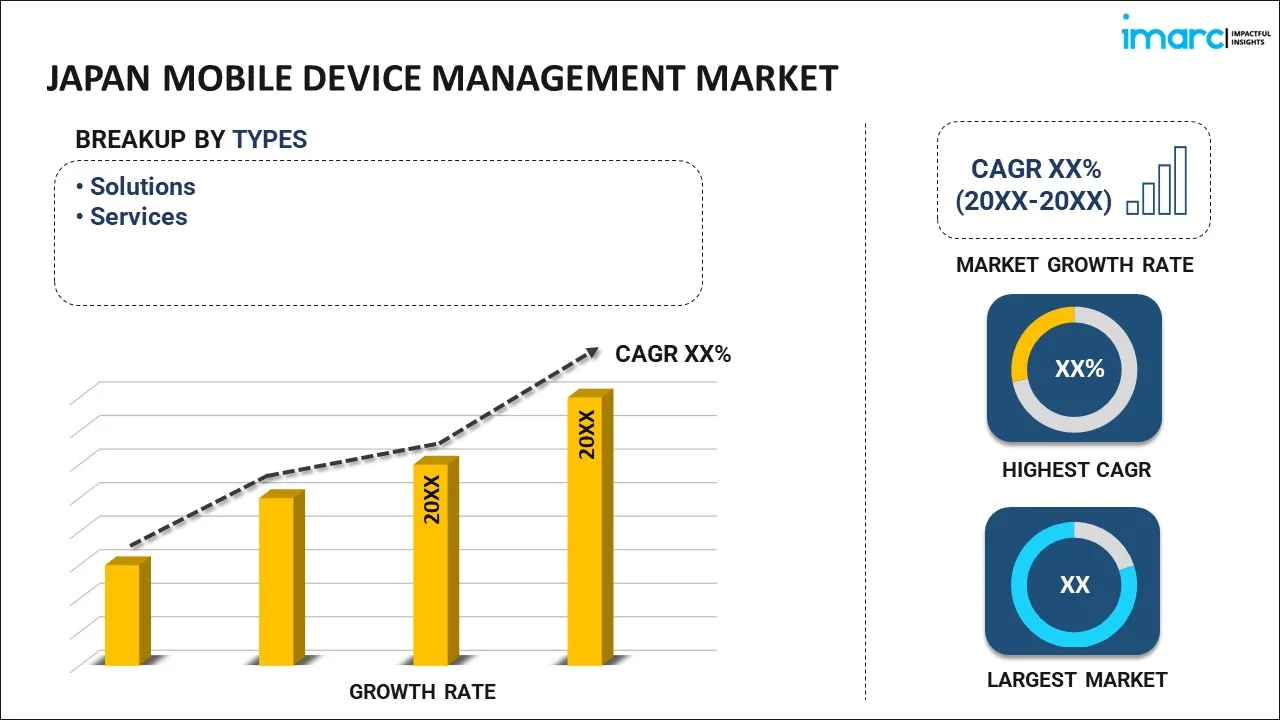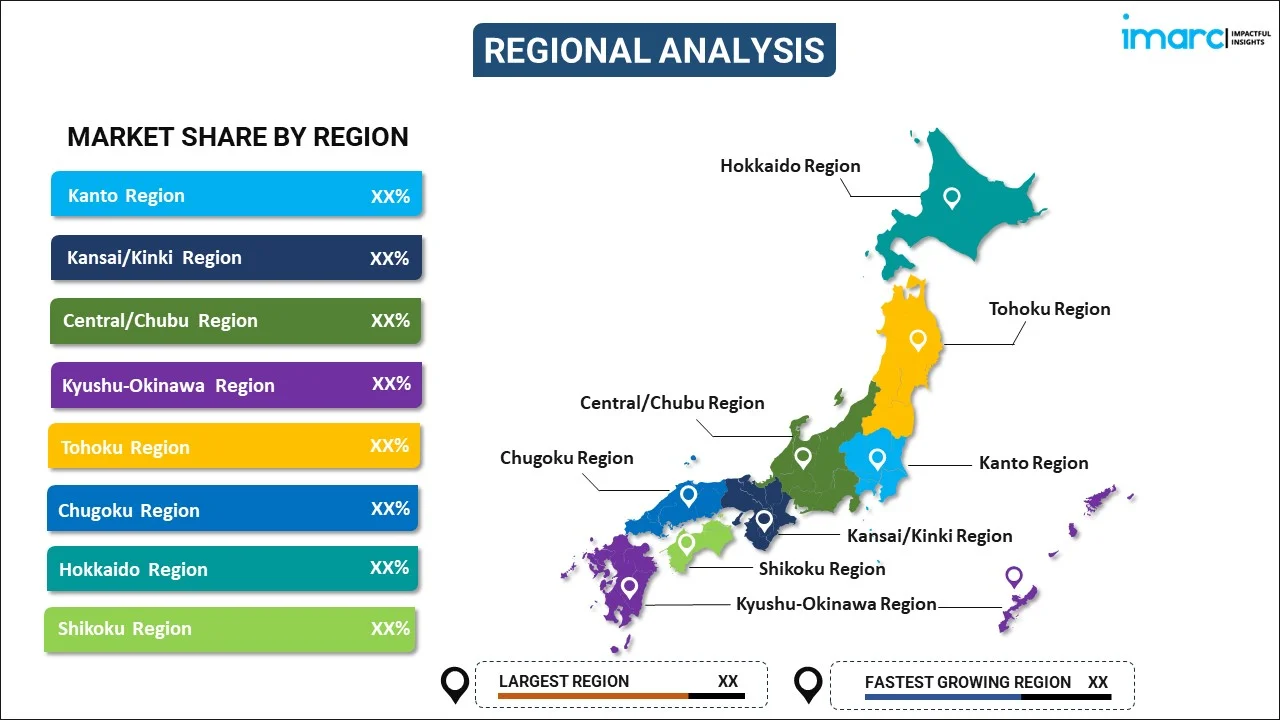
Japan Mobile Device Management Market Report by Type (Solutions, Services), Deployment Type (On-premises, Cloud-based), Organization Size (Large Enterprises, Small and Medium-sized Enterprises), Vertical (BFSI, Manufacturing, Healthcare, Communication, and Others), and Region 2025-2033
Market Overview:
Japan mobile device management market size reached USD 483.6 Million in 2024. Looking forward, IMARC Group expects the market to reach USD 4,069.1 Million by 2033, exhibiting a growth rate (CAGR) of 24.3% during 2025-2033. The increasing adoption of smartphones and tablets for both personal and business use that has led to a surge in the number of mobile devices within organizations, is primarily driving the market.
|
Report Attribute
|
Key Statistics
|
|---|---|
|
Base Year
|
2024 |
|
Forecast Years
|
2025-2033
|
|
Historical Years
|
2019-2024
|
| Market Size in 2024 | USD 483.6 Million |
| Market Forecast in 2033 | USD 4,069.1 Million |
| Market Growth Rate (2025-2033) | 24.3% |
Mobile device management (MDM) is a comprehensive solution designed to manage and secure mobile devices, such as smartphones and tablets, within an organization. It enables IT administrators to remotely control and monitor these devices, regardless of their operating systems or locations. MDM offers various essential features, including device provisioning, configuration, and software updates. It allows administrators to enforce security policies, such as password requirements and encryption, to protect sensitive data on mobile devices. Additionally, MDM enables remote troubleshooting and support, ensuring that devices function optimally. Moreover, MDM helps organizations track device inventory, monitor usage patterns, and implement application management, making it easier to ensure compliance with company policies and regulatory requirements. This technology is vital in enhancing productivity, reducing security risks, and streamlining the management of mobile assets in today's increasingly mobile-oriented business environment.
Japan Mobile Device Management Market Trends:
The mobile device management market in Japan is experiencing substantial growth due to several key drivers. Firstly, the proliferation of smartphones and tablets in the workplace has created a pressing need for effective MDM solutions. Consequently, organizations are increasingly recognizing the importance of securing and managing these devices to safeguard sensitive corporate data. Moreover, the rise of remote work and the bring-your-own-device (BYOD) trend has further fueled the demand for MDM solutions. As a result, companies are seeking versatile MDM platforms that can seamlessly adapt to the diverse range of devices and operating systems employees use. Additionally, the ever-evolving threat landscape has emerged as a crucial driver for the MDM market. With an increasing number of cyberattacks targeting mobile devices, businesses are compelled to invest in robust MDM solutions to fortify their defenses. Furthermore, compliance with data privacy regulations, such as GDPR and HIPAA, has become non-negotiable, driving organizations to adopt MDM solutions that help them meet regulatory requirements. In conclusion, the confluence of factors, including the proliferation of mobile devices, the surge in remote work, heightened cybersecurity concerns, and stringent data privacy regulations, is expected to drive the mobile device management market in Japan during the forecast period.
Japan Mobile Device Management Market Segmentation:
IMARC Group provides an analysis of the key trends in each segment of the market, along with forecasts at the country level for 2025-2033. Our report has categorized the market based on type, deployment type, organization size, and vertical.
Type Insights:

- Solutions
- Services
The report has provided a detailed breakup and analysis of the market based on the type. This includes solutions and services.
Deployment Type Insights:
- On-premises
- Cloud-based
A detailed breakup and analysis of the market based on the computing services have also been provided in the report. This includes on-premises and cloud-based.
Organization Size Insights:
- Large Enterprises
- Small and Medium-sized Enterprises
The report has provided a detailed breakup and analysis of the market based on the organization size. This includes large enterprises and small and medium-sized enterprises.
Vertical Insights:
- BFSI
- Manufacturing
- Healthcare
- Communication
- Others
A detailed breakup and analysis of the market based on the vertical have also been provided in the report. This includes BFSI, manufacturing, healthcare, communication, and others.
Regional Insights:

- Kanto Region
- Kansai/Kinki Region
- Central/ Chubu Region
- Kyushu-Okinawa Region
- Tohoku Region
- Chugoku Region
- Hokkaido Region
- Shikoku Region
The report has also provided a comprehensive analysis of all the major regional markets, which include Kanto Region, Kansai/Kinki Region, Central/ Chubu Region, Kyushu-Okinawa Region, Tohoku Region, Chugoku Region, Hokkaido Region, and Shikoku Region.
Competitive Landscape:
The market research report has also provided a comprehensive analysis of the competitive landscape. Competitive analysis such as market structure, key player positioning, top winning strategies, competitive dashboard, and company evaluation quadrant has been covered in the report. Also, detailed profiles of all major companies have been provided.
Japan Mobile Device Management Market Report Coverage:
| Report Features | Details |
|---|---|
| Base Year of the Analysis | 2024 |
| Historical Period | 2019-2024 |
| Forecast Period | 2025-2033 |
| Units | Million USD |
| Scope of the Report | Exploration of Historical and Forecast Trends, Industry Catalysts and Challenges, Segment-Wise Historical and Predictive Market Assessment:
|
| Types Covered | Solutions, Services |
| Deployment Types Covered | On-premises, Cloud-based |
| Organization Sizes Covered | Large Enterprises, Small and Medium-sized Enterprises |
| Verticals Covered | BFSI, Manufacturing, Healthcare, Communication, Others |
| Regions Covered | Kanto Region, Kansai/Kinki Region, Central/ Chubu Region, Kyushu-Okinawa Region, Tohoku Region, Chugoku Region, Hokkaido Region, Shikoku Region |
| Customization Scope | 10% Free Customization |
| Post-Sale Analyst Support | 10-12 Weeks |
| Delivery Format | PDF and Excel through Email (We can also provide the editable version of the report in PPT/Word format on special request) |
Key Questions Answered in This Report:
- How has the Japan mobile device management market performed so far and how will it perform in the coming years?
- What has been the impact of COVID-19 on the Japan mobile device management market?
- What is the breakup of the Japan mobile device management market on the basis of type?
- What is the breakup of the Japan mobile device management market on the basis of deployment type?
- What is the breakup of the Japan mobile device management market on the basis of organization size?
- What is the breakup of the Japan mobile device management market on the basis of vertical?
- What are the various stages in the value chain of the mobile device management market?
- What are the key driving factors and challenges in the Japan mobile device management?
- What is the structure of the Japan mobile device management market and who are the key players?
- What is the degree of competition in the Japan mobile device management market?
Key Benefits for Stakeholders:
- IMARC’s industry report offers a comprehensive quantitative analysis of various market segments, historical and current market trends, market forecasts, and dynamics of the Japan mobile device management market from 2019-2033.
- The research report provides the latest information on the market drivers, challenges, and opportunities in the Japan mobile device management market.
- Porter's five forces analysis assist stakeholders in assessing the impact of new entrants, competitive rivalry, supplier power, buyer power, and the threat of substitution. It helps stakeholders to analyze the level of competition within the Japan mobile device management industry and its attractiveness.
- Competitive landscape allows stakeholders to understand their competitive environment and provides an insight into the current positions of key players in the market.
Need more help?
- Speak to our experienced analysts for insights on the current market scenarios.
- Include additional segments and countries to customize the report as per your requirement.
- Gain an unparalleled competitive advantage in your domain by understanding how to utilize the report and positively impacting your operations and revenue.
- For further assistance, please connect with our analysts.
 Inquire Before Buying
Inquire Before Buying
 Speak to an Analyst
Speak to an Analyst
 Request Brochure
Request Brochure
 Request Customization
Request Customization




.webp)




.webp)












